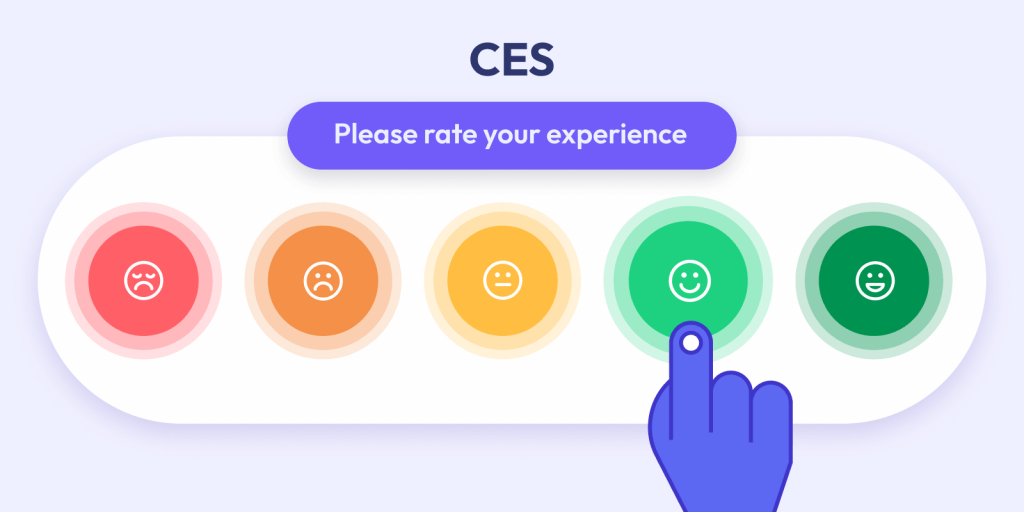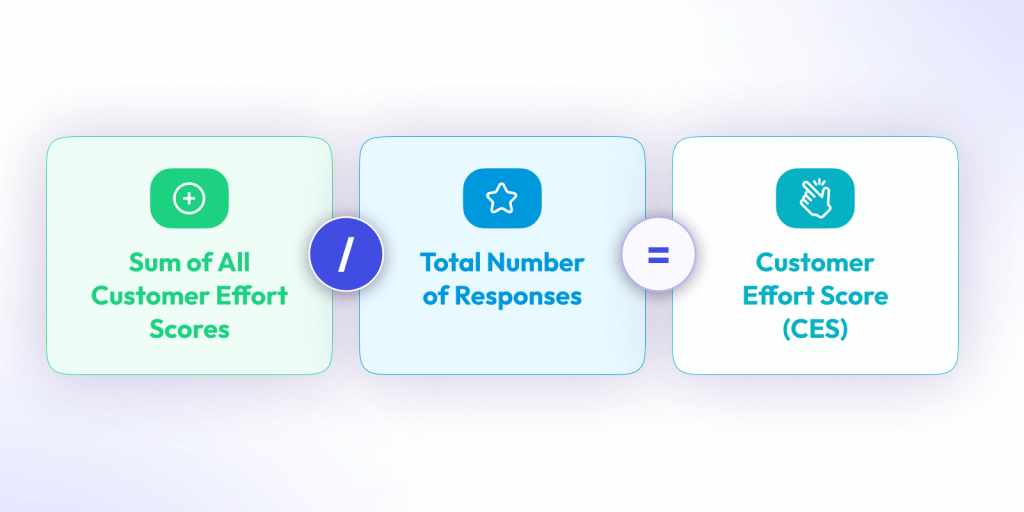What is Customer Effort Score & How to Improve it?
- January 22nd, 2025 / 5 Mins read
-
Harshitha Raj
What is Customer Effort Score & How to Improve it?
- January 22nd, 2025 / 5 Mins read
-
Harshitha Raj
The Customer Effort Score (CES) assesses how much effort customers must make to fix an issue or complete a task with a company. It is an important metric of customer experience since it directly correlates with customer happiness and loyalty. According to studies, The majority of customers, specifically 96%, consumers who had high-effort interactions reported being disloyal, compared to only 9% of consumers who had low-effort experiences. Businesses can increase overall satisfaction and encourage repeat business by focusing on lowering the amount of work required. Improving CES entails streamlining processes, simplifying interactions, and providing clear and accessible support.
Understanding and measuring CES can result in more efficient and better client experiences, which drives long-term success. In this article, we’ll discuss customer effort scores, their importance, how to calculate them, and many other things in detail.
What is the Customer Effort Score (CES)?
The Customer Effort Score (CES) calculates how much effort it takes for a client to receive what they require from your brand, whether it’s resolving a problem, responding to a query, or completing a specific task. The ultimate purpose of customer effort score is to offer customers a hassle-free experience.
Companies usually assess their CES by conducting surveys in which customers rate the ease of interaction on a scale of “very easy” to “very difficult.” A high CES indicates little customer effort or simple transactions. A low CES score indicates excessive customer effort and, more likely, a significant number of dissatisfied customers.

Why is CES Important?
The importance of CES derives from understanding customers’ efforts and feedback on trouble issues, which can assist you give low-effort expertise. This promotes conversions, retention, and also brand loyalty.
Provides details about your support services: CES keeps you informed about how well your support services are running. You can use the information to improve existing service channels, introduce new service points, and remove ineffective processes that limit an exceptional client experience.
Lowers service costs and efforts: If clients make less effort to fix their concerns, your support team will be more comfortable, resulting in lower resource expenses. A low-effort experience may reduce repeat calls, saving service resources and time. Because this score directly reflects the customer’s difficulties, it may help you identify areas for improvement in order to provide a quick response.
Examples and Case Studies
- Case Study 1: Zappos
Zappos, an online shoe and clothes shop, has long been regarded for providing excellent customer service. They use CES to track and reduce customers’ efforts to address problems or return items. Zappos has established an excellent reputation for customer loyalty by investing in customer service and making processes like returns simple and hassle-free.
- Case Study 2: Microsoft
Microsoft included CES in their support workflows to improve the customer experience. They aimed to improve technical support interactions by streamlining the steps required to fix issues. As a result, Microsoft experienced significant increases in customer satisfaction and decreased support-related complaints.
- Case Study 3: American Express
American Express uses CES to evaluate and improve its customer service operations. Businesses that evaluate CES data can quickly discover and address friction points in consumer interactions. This proactive technique has enabled American Express to retain high levels of client loyalty and satisfaction.
How to Calculate CES?
After collecting CES data, calculate your actual Customer Effort Score. Each response should be rated, with lower numbers indicating more significant effort. For example, if the responses vary from very difficult to very easy, one point would be assigned to very difficult and five points to very easy. Here’s how you can utilise information to calculate CES.
Customer Effort Score Formula

CES can be calculated by dividing the overall ratings by the total number of survey respondents. As previously said, if your comments are not numbered (for example, if your customers use an emoticon or emoji to express their feelings), offer a higher value to good responses and a lower value to negative responses.
The sum of CES ratings ÷ Number of survey responses = CES
If you’re using an emoticon/emoji scale, subtract the percentage of negative responses from the percentage of positive ones to calculate your CES, excluding neutral responses.
Percentage of positive responses – Percentage of negative responses = CES
Assume you send out a survey that 300 individuals complete. There are 250 positive and 50 negative responses.
First, you’ll calculate the percentages of each form of response:
(250 ÷ 300) x 100 = 83.33% positive
(50 ÷ 300) x 100 = 16.66% negative
Subtract the negative percentage from the positive percentage to determine your CES now:
83.33 – 16.66 = 66.67
Different Types of Customer Effort Score Questions
Customers can rate how easy or difficult a job was for them to perform by answering brief Customer Effort Score surveys. Companies usually utilise one of four types of CES surveys.
1. Numbered CES survey questions
Customer ratings of their interactions are requested on a numerical scale using numbers in CES survey questions. These questions usually have a higher response rate because they are simple to grasp and can be answered quickly. For instance, CES survey questions using numbers may resemble this:
Q: How simple was it to use [Name of Product or Service]?
Q: To what extent was following our customer service representatives’ instructions simple?
Q: How challenging do you think our product lessons are to understand?
Q: How simple was changing the product to suit your requirements?
A: 1 is the easiest, 2, 3, 4, 5 is the most difficult.
2. Open-ended CES survey questions
Open-ended CES survey questions allow participants to describe an experience in their own words rather than asking them to select from a list of possibilities. Even though a customer in a hurry might ignore this problem, the replies usually contain information that multiple-choice or Likert questions should have covered. Answers to questions with no limits are also usually more helpful.
Examples of open-ended CES questions are as follows:
- What is one aspect of your dealings with our company that you would have changed, and why?
- Which software feature is your least favourite?
- Which product attributes resulted in the highest return on investment for your company?
3. Likert CES survey questions

Customers are asked to rate a company, product, or experience on a predetermined scale in Likert CES questions. Customers can select a neutral option and provide more nuanced feedback beyond just positive or negative, as there are usually an odd number of possibilities. In contrast to open-ended questions, this organised method makes interpretation easier and promotes more thoughtful answers.
Here are a few instances of Likert questions:
Q: To what extent was [Product/Service Name] user-friendly?
Extremely difficult, complex, neutral, simple, simple, very easy
Q: To what extent did our website help you find what you needed?
Very difficult, complex, neutral, easy, very easy
Crafting an Effective CES Survey
There are several aspects to consider when creating a CES survey. These pointers will help you collect more responses.
Time the survey right: Send surveys in the proper context. For example, instead of waiting a few days for a response on a support encounter, send a CES survey as soon as the issue is handled.
Send the survey through the proper channels: Make it easy to complete your CES survey. Send queries through the channels with the highest consumer interaction.
Leverage AI: Simplify the way you distribute surveys. AI agents may automatically provide CES questionnaires for your organisation after each client engagement, enabling you to collect more feedback.
Use neutral language: Leading inquiries are not suitable for acquiring customer information. Questions such as “How do you feel about our awesome product?” influence responses and do not offer accurate CES scores.
Set goals for your survey: An effective survey begins with a goal. You can improve your understanding of the checkout process or plan when your customer success team should contact you. Begin with a defined purpose, and then design your survey around it.
Consider this open-ended option: Open-ended questions allow customers to fill up any gaps your CES survey may not address. Although open-ended responses are more subjective, they provide essential context for your data.
5 Strategies to Boost Your Customer Effort Score
Increasing your Customer Effort Score (CES) includes reducing consumers’ efforts to resolve issues or achieve their goals with your product or services. Here are some tips for boosting CES:
1. Simplify Processes:
Streamline customer interactions by simplifying processes. Reduce the number of steps needed to complete tasks or solve problems. Ensure your website, app, or support channels are simple.
2. Improve Self-Service Options:
Use comprehensive features like FAQs, knowledge bases, and chatbots. Make sure these resources are easily available and offer simple, concrete solutions to frequent issues.
3. Improve Communication Channels:
Ensure all communication channels are efficient and responsive. Provide several contact options (phone, email, and chat) and ensure timely and informative responses. Clear and consistent communication reduces consumer effort.
4. Train and Empower Employees:
Train your support staff to handle inquiries efficiently, and provide them with the tools and authority to fix difficulties on the spot. If employees are appropriately trained, customers may not need to follow up or escalate problems.
5. Collect and Act on Feedback:
Gather consumer input regularly and discover areas of difficulty. Use this input to continuously enhance your procedures, support systems, and customer experience.
Additional CX Metrics to Evaluate Beyond CES
Remember that the Customer Effort Score is not the only way to evaluate consumer effort. You should also be aware of the following customer service KPIs:
Customer satisfaction (CSAT): Customer satisfaction (CSAT) determines how positively or badly customers perceive customer support interactions.
Net Promoter Score (NPS): The Net Promoter Score (NPS) determines how likely customers are to promote your product or service to others.
Agent Touches: Determine the number of interactions between your consumers and representatives on the same ticket.
Average Handle Time (AHT): It estimates the average time it takes to resolve a ticket once a consumer submits it.
Future Trends in CES
As organisations focus on the customer experience, the development and measurement of CES is rapidly growing. Several key factors are likely to influence future CES developments.
AI and Machine Learning Integration
AI and machine learning are revolutionising CES by offering more in-depth insights and prediction capabilities. Artificial intelligence examines enormous amounts of customer interaction data to detect patterns and predict problems, whereas machine learning algorithms provide real-time insights and personalised solutions. This integration allows firms to address problem spots proactively, increasing customer happiness while lowering overall effort.
Real-Time Feedback and Response
Real-time feedback systems are becoming more crucial for developing CES. With technological improvements, organisations can collect and analyse client feedback in real-time. This urgency enables speedier reaction times and the ability to address consumer problems before they grow. Implementing real-time feedback tools like in-app surveys or live chat capabilities can dramatically improve the overall customer experience.
Personalisation Through Technology
Personalisation is an emerging concept at CES. AI and machine learning enable organisations to personalise interactions and assist with specific client demands. Companies can provide personalised solutions that minimise work and increase satisfaction by analysing previous interactions and preferences.
Improve CES With Verloop.io
Verloop.io improves CES by using AI-powered customer support automation to optimise consumer interactions. The platform combines support tools to provide personalised, real-time assistance across numerous channels. Verloop.io identifies issues and provides actionable insights based on customer data and feedback, enabling businesses to minimise consumer effort while enhancing overall satisfaction. Its smooth, automated solutions improve CES management efficiency and effectiveness.






